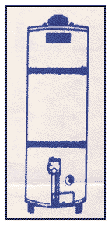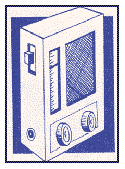The Salt Lake Valley sits in an active seismic zone that could experience a major earthquake event.
To help you prepare for such an emergency, the Salt Lake City Department of Public Utilities asked the professionals at the Utah Geological and Mineral Survey and the Salt Lake City-County Health Department for advice and prepared this information for your safety.
Keep this information handy. Place it near your hot water heater, which, in an emergency, can be used as a source of safe drinking water.
Earthquakes occur when one block of the earth’s crust moves with respect to another along a fault line. Utah has several fault lines running generally north to south of Nephi in Juab County. This fault isn’t continuous. Rather, it is broken into segments of about 25 miles in length that moves independently. The Salt Lake segment hugs the east side of the valley from the Point of the Mountain to Beck’s Hot Springs. A major earthquake along this segment would disrupt the water supply by cutting the major aqueducts leading from the canyons.
Groundshaking will spread many miles from the fault and most likely will be more severe in the central part of the valley due to liquefaction, an event that causes waves in sandy soils much like waves on an ocean. This action could also damage water and sewer facilities over a wide area.
The geologic record indicates that a major quake occurs on the Salt Lake segment about once every 2,000 years. Such a quake has not occurred for at least 1,000 years.
A major quake occurs somewhere along the Wasatch Fault on the average of once every 400 years. Any one of these may cause severe groundshaking in the Salt Lake Valley, which could damage the water system.
The Salt Lake City Public Utilities Department has an earthquake preparedness plan to minimize service disruptions and to make system repairs if a major earthquake strikes. The Department also functions under direction of the Salt Lake City and Salt Lake County emergency plans.
The Department has trained its employees in earthquake response; however during a major emergency, they will be working on system-wide repairs and most likely you will have to provide for yourself for the first 24 to 48 hours after a major event with wide-spread damage.
Over the past years, as part of the Department’s capital improvements program, dams, water treatment plants, reservoirs and other facilities have been upgraded to meet current seismic code standards. For example the Big Cottonwood Water Treatment Plant located at the mouth of Big Cottonwood Canyon is now under reconstruction to meet current standards. However, it must be assumed that a major earthquake event will cause damage to water and sewer facilities, resulting in the disruption of these vital services.
You can help prepare your family and home by doing the following:
|
 |
Store at least three gallons of culinary water for each person in your house. Store more if space is available. Water may be stored in clean bottles and changed every six months. A cleaned liter soda bottle is a good storage choice. Add ¼ teaspoon of bleach, not the scented type, to each gallon of stored water. This is an additional protection for the water since it will be stored for an extended time period.
|
 |
Remember that ice cubes in the refrigerator and water in the toilet tank (not toilet bowl) that has not been chemically treated also may be used in an emergency.
Keep calm and turn off all water that you might have running. This especially is true for outside hoses and sprinkler systems. Treated water already in the system might be needed to fight fires. The bathtub should never to be used to store drinking water because it harbors large numbers of bacteria, cleaning chemicals and soap.
Listen to a battery-powered radio, which can advise you about the safety of water supplies and the locations of emergency sources.
Don’t drink tap water until you’ve been told it safe.
If there is widespread damage resulting from an earthquake, it’s possible that ruptured sewer lines could contaminate the drinking water system. Listen for public radio announcements to declare if the water is safe or unsafe to drink. If you are in doubt rely on stored water within your home or workplace until you know for certain that the water is safe to drink.
In an emergency, water can be purified (at least improved) by filtering it through several layers of clean cloth or coffee filters and then boiling it vigorously for five minutes.
Although there are a number of devices, which claim to "purify" water, remember that "purifiers" cannot produce water. You must have stored water to treat. Even the distillation of water can result in an unsafe product if certain organic contaminants are in the original supply.
Have on hand emergency supplies and equipment. Share the locations of flashlights, battery-operated radios, spare batteries, medications, first aid kits, survival booklets, blankets, canned food, stored water and simple hand tools with your family members. Your best tools in an emergency are preparation and common sense. Be prepared by having emergency supplies, equipment an adequate supply of safe drinking water available for emergency use. |
 |
Mail Stuffer – 1990 - edited 1999
Questions regarding this can be directed to: florence.reynolds@ci.slc.ut.us